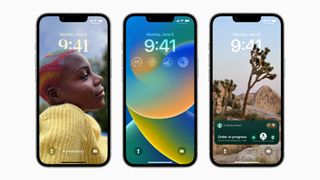A breakdown of iOS 16's security features
Digital passkeys, faster security updates and a 15-minute window to fix or recall iMessages and emails

With its iPhone 14 launch out the way, Apple has begun releasing iOS 16 which will come with a host of new features and designs for compatible devices.
The next version of its smartphone operating system was unveiled at its developer conference in June and it offered users a glimpse at several new security controls and privacy features. Most of these will be of some interest to businesses, particularly their remote employees, though not all of the capabilities will be available straight away.
All eligible devices will be able to download iOS16 straight away, though users will need an iPhone 8 model or newer (iPhone SE also included). To get started, users need to open the settings app, navigate to 'General', then 'Software Update' and tap install. The device will reboot itself.
iOS 16: passkeys, Lockdown mode, decoupled updates and message recall
Digital keys can now be used on iPhones to authenticate a user's face or fingerprint when they sign into websites, apps and other services. This will replace standard passwords and will also work on other non-Apple products, including when logging into a smart TV. Users will still need to scan a QR code to link, but the iPhone will then use passkeys to confirm with either finger or facial recognition. What's more, the passkeys will be synced with iCloud Keychain and users can recover them if they are lost or their handset is broken.
A new Lockdown mode is also available for users. This is perhaps a specialist service in that not all users will need it as it is for those that might have reason to believe they are the target of state-sponsored spyware, such as Pegasus or Predator. It adds several restrictions and even blocks certain types of data transfer. For example, most major types of attachments will be blocked, including features like link preview. If a FaceTime request comes in from a contact that the user has no previous history with, the request will automatically be denied. It is a strict set of protocols, but also worth pointing out that it will limit what you can do with your iPhone.
Also coming with iOS 16, iPhones will receive faster security updates as Apple has decoupled them from full iOS updates. This allows the tech company to release bug fixes and patches quicker and have them automatically installed on iPhones.
There are greater editing controls for both iMessages and Mail that allow users to tweak and even recall messages after they've been sent. For iMessages, there is a 15-minute window to recall and change, though Mail messages need to be recalled before it reaches the recipient (roughly about 10 seconds). The Mail app will also use machine learning-based pop-up warnings if a user forgets to attach something to an email or misses the user's address.
Get the ITPro. daily newsletter
Receive our latest news, industry updates, featured resources and more. Sign up today to receive our FREE report on AI cyber crime & security - newly updated for 2024.
Bobby Hellard is ITPro's Reviews Editor and has worked on CloudPro and ChannelPro since 2018. In his time at ITPro, Bobby has covered stories for all the major technology companies, such as Apple, Microsoft, Amazon and Facebook, and regularly attends industry-leading events such as AWS Re:Invent and Google Cloud Next.
Bobby mainly covers hardware reviews, but you will also recognize him as the face of many of our video reviews of laptops and smartphones.





